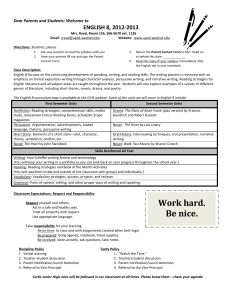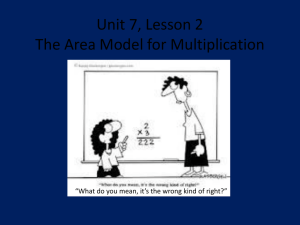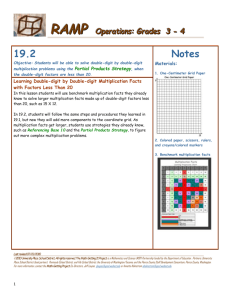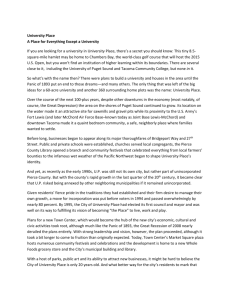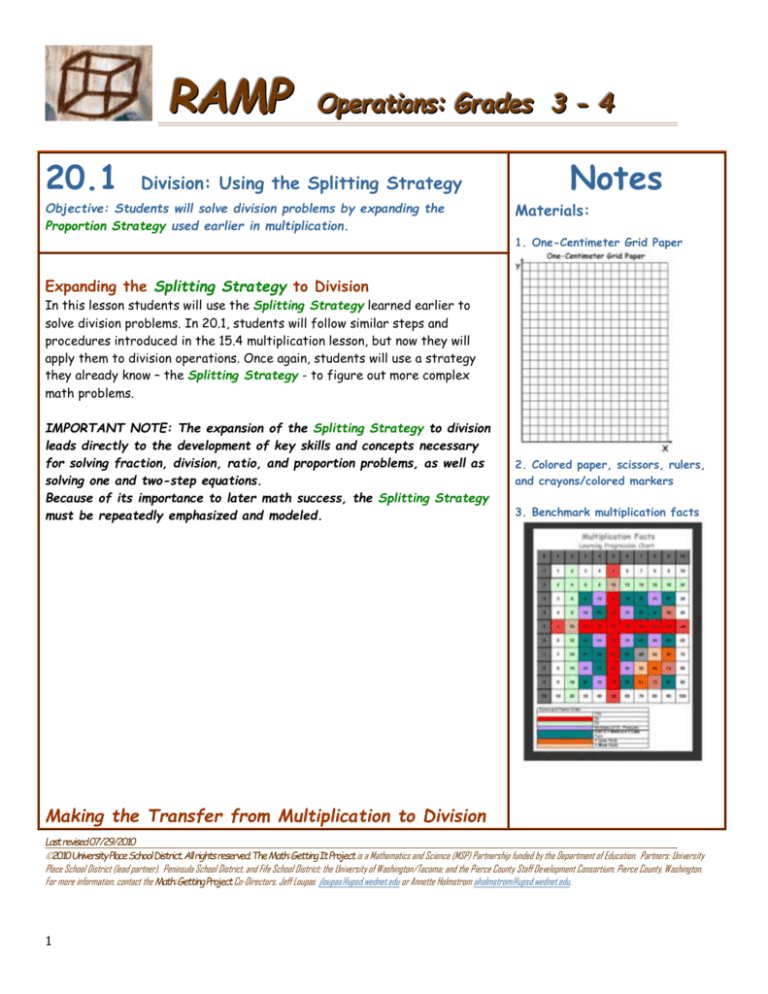
RAMP
20.1
Operations: Grades 3 - 4
Division: Using the Splitting Strategy
Objective: Students will solve division problems by expanding the
Proportion Strategy used earlier in multiplication.
Notes
Materials:
1. One-Centimeter Grid Paper
Expanding the Splitting Strategy to Division
In this lesson students will use the Splitting Strategy learned earlier to
solve division problems. In 20.1, students will follow similar steps and
procedures introduced in the 15.4 multiplication lesson, but now they will
apply them to division operations. Once again, students will use a strategy
they already know – the Splitting Strategy - to figure out more complex
math problems.
IMPORTANT NOTE: The expansion of the Splitting Strategy to division
leads directly to the development of key skills and concepts necessary
for solving fraction, division, ratio, and proportion problems, as well as
solving one and two-step equations.
Because of its importance to later math success, the Splitting Strategy
must be repeatedly emphasized and modeled.
2. Colored paper, scissors, rulers,
and crayons/colored markers
3. Benchmark multiplication facts
Making the Transfer from Multiplication to Division
Last revised 07/29/2010
2010 University Place School District. All rights reserved. The Math: Getting It Project is a Mathematics and Science (MSP) Partnership funded by the Department of Education. Partners: University
Place School District (lead partner), Peninsula School District, and Fife School District; the University of Washington/Tacoma; and the Pierce County Staff Development Consortium, Pierce County, Washington.
For more information, contact the Math:Getting Project Co-Directors, Jeff Loupas jloupas@upsd.wednet.edu or Annette Holmstrom aholmstrom@upsd.wednet.edu,
1
RAMP
Operations: Grades 3 - 4
START by repeating the proportion multiplication activities from earlier
lessons. Then purposefully change the language into division
language.
DO Have students practice using the Proportion Strategy to figure out
factors and products for 24 in the same way they did in earlier multiplication
lessons: students cut rectangles with smaller areas and placed them on top of
larger rectangles, or folded these areas into smaller rectangular areas,
identifying the possible factors and the final products for the smaller facts.
Students should be able to
identify, label, and fill in the
pieces of the division problem
given an area model or rectangle.
These skills become crucial in:
divisibility, factoring, equivalent
fractions, one and two step
equations, factoring polynomials…
SAY So when we look at the product 24 when it is folded in
two parts of 12 each, it gives us the multiplication fact 12 x
Last revised 07/29/2010
2010 University Place School District. All rights reserved. The Math: Getting It Project is a Mathematics and Science (MSP) Partnership funded by the Department of Education. Partners: University
Place School District (lead partner), Peninsula School District, and Fife School District; the University of Washington/Tacoma; and the Pierce County Staff Development Consortium, Pierce County, Washington.
For more information, contact the Math:Getting Project Co-Directors, Jeff Loupas jloupas@upsd.wednet.edu or Annette Holmstrom aholmstrom@upsd.wednet.edu,
2
RAMP
Operations: Grades 3 - 4
2 = 24. This can also be turned around to become a division
problem: 24 divided by 2 = 12.
SAY When it becomes a division problem, the larger
rectangle (24), changes from being the product, or total, to
the dividend, which is the total value that is divided into
parts.
These skills become crucial in:
multiplication of fractions,
understanding fractions as
division, understanding the
concept of fair sharing,
divisibility…
The move from additive [(3 X 4) +
(3 X 4) = 6 X 4] to multiplicative
[2 X (3 X 4)] representation
reinforces the relationship
between the two that is a crucial
connection later.
SAY When you turn the multiplication problem into a division
problem, the factors turn into the divisor and the quotient:
Last revised 07/29/2010
2010 University Place School District. All rights reserved. The Math: Getting It Project is a Mathematics and Science (MSP) Partnership funded by the Department of Education. Partners: University
Place School District (lead partner), Peninsula School District, and Fife School District; the University of Washington/Tacoma; and the Pierce County Staff Development Consortium, Pierce County, Washington.
For more information, contact the Math:Getting Project Co-Directors, Jeff Loupas jloupas@upsd.wednet.edu or Annette Holmstrom aholmstrom@upsd.wednet.edu,
3
RAMP
Operations: Grades 3 - 4
Dividend: the total value (squares) of the larger rectangle
Divisor: how many parts the rectangle will be divided into
Quotient: how many squares in each part
SAY For example, 24 is the dividend because it represents
the larger rectangle that will be divided up or shared
equally.
SAY 2 is the divisor because that is how many parts
you will be dividing the larger rectangle, or dividend, into
SAY 12 is the quotient because it represents the number of
squares in each part, which is the answer to the division
problem 24 ÷ 2 = 12.
Last revised 07/29/2010
2010 University Place School District. All rights reserved. The Math: Getting It Project is a Mathematics and Science (MSP) Partnership funded by the Department of Education. Partners: University
Place School District (lead partner), Peninsula School District, and Fife School District; the University of Washington/Tacoma; and the Pierce County Staff Development Consortium, Pierce County, Washington.
For more information, contact the Math:Getting Project Co-Directors, Jeff Loupas jloupas@upsd.wednet.edu or Annette Holmstrom aholmstrom@upsd.wednet.edu,
4
RAMP
Operations: Grades 3 - 4
DO Teach students the division vocabulary, as well as the meaning of the
division symbol (÷) and the division brackets, by pointing out where the parts
of the problem are in division problems related to the dividend 24.
DO/SHOW Write the problem 24 ÷ 3 = 8 in sentence form and in bracket
form on the board, minus the labels for division vocabulary. Show students
the 8 X 3 = 24 grid example we made earlier when practicing the proportion
strategy for multiplication, folded into three parts.
ASK In the division problem 24 ÷ 3 = 8, what is the
dividend? How do you know? Have students show and explain, using
the folded grid to illustrate.
Last revised 07/29/2010
2010 University Place School District. All rights reserved. The Math: Getting It Project is a Mathematics and Science (MSP) Partnership funded by the Department of Education. Partners: University
Place School District (lead partner), Peninsula School District, and Fife School District; the University of Washington/Tacoma; and the Pierce County Staff Development Consortium, Pierce County, Washington.
For more information, contact the Math:Getting Project Co-Directors, Jeff Loupas jloupas@upsd.wednet.edu or Annette Holmstrom aholmstrom@upsd.wednet.edu,
5
RAMP
Operations: Grades 3 - 4
ASK In the division problem 24 ÷ 3 = 8, what is the divisor?
How do you know?
ASK In the division problem 24 ÷ 3 = 8, what is the
quotient? How do you know?
DO Continue having students learn and practice identifying these parts,
using
24 ÷ 4 = 6
24 ÷ 6 = 4
24 ÷ 8 = 3
24 ÷ 2 = 12.
NEXT Once students know the vocabulary, use the Proportion Strategy to
figure out other division problems. Have students fold a dividend such as 48,
for example, in even parts (4 parts for 4 X 12 =48, 6 parts for 6 X 8 = 48,
etc.), identifying the components of division problems, referenced to the
folded grid rectangles.
As we make the transition from multiplication to division, our basic questions
change from ones such as “Can we break our larger rectangle (the product)
into smaller pieces (factors and products) we already know?” to questions
such as:
How many parts (the quotient) can we evenly divide the
larger rectangle (the dividend) into evenly?
Can we divide the larger rectangle (the dividend) evenly
into three parts (the divisor) or how about four…?
Note: These questions help students develop patterns or rules to determine
whether these areas can be broken evenly.
For example, students discover that even areas can always be divided into
two parts. They learn that dividing an area into two and three parts is
the same as dividing it into six parts. This work teaches the concept of
divisibility, aids in understanding of equivalent fractions, and helps students
solve one and two step equations later on.
Linking Division to Fraction Concepts and Language
Last revised 07/29/2010
2010 University Place School District. All rights reserved. The Math: Getting It Project is a Mathematics and Science (MSP) Partnership funded by the Department of Education. Partners: University
Place School District (lead partner), Peninsula School District, and Fife School District; the University of Washington/Tacoma; and the Pierce County Staff Development Consortium, Pierce County, Washington.
For more information, contact the Math:Getting Project Co-Directors, Jeff Loupas jloupas@upsd.wednet.edu or Annette Holmstrom aholmstrom@upsd.wednet.edu,
6
RAMP
Operations: Grades 3 - 4
DO Once students can identify and explain these division concepts,
introduce language that connects these models to fraction concepts and use
fraction language that will be introduced in RNP1. For example:
SAY Can we divide the rectangle into 4 parts?
SAY Can we break the rectangle into fourths?
SAY How many squares are in one fourth?
SAY If the whole is 24 squares, what fraction would 6
squares represent?
Note: Students may need to shade or cut the whole (24) into parts to see the
fraction and match the language for fractions with the image (like in RNPi
chips).
Reinforcing Factors/factoring Concepts
In the original multiplication lessons, when teachers used the More Area
Last revised 07/29/2010
2010 University Place School District. All rights reserved. The Math: Getting It Project is a Mathematics and Science (MSP) Partnership funded by the Department of Education. Partners: University
Place School District (lead partner), Peninsula School District, and Fife School District; the University of Washington/Tacoma; and the Pierce County Staff Development Consortium, Pierce County, Washington.
For more information, contact the Math:Getting Project Co-Directors, Jeff Loupas jloupas@upsd.wednet.edu or Annette Holmstrom aholmstrom@upsd.wednet.edu,
7
RAMP
Operations: Grades 3 - 4
Compare Strategy and the Proportion Strategy, the concept was additive.
For example, (3 X 4) + (3 X 4) = 6 X 4.
Once students understand basic division concepts, teachers can return to
multiplication for a moment and help students transition from this additive
concept to the more multiplicative concept that division concepts encourage.
For example, instead of:
ADDITIVE
(3 x 4) + (3 x 4) = 6 X 4
MULTIPLICATIVE
2 x (3 x 4) = 6 x 4
ADDITIVE
MULTIPLICATIVE
(3 x 4) + (3 x 4) = 6 X 4
2 x (3 x 4) = 6 x 4
Be sure to point out that because the pieces are all
the same size, the relationship between the
small and large rectangles can be represented as a
multiplication problem.
For example, because it takes two 3 X 4 rectangles
to cover the 6 X 4 rectangle, 2 X (3 X 4) = 6 X 4.
Students need to be able to move fluently between representations. They
also need to be able to identify which products (dividends) can be
represented only additively (like 15, 5 X 3 = 4 X 3 + 1 X 3), multiplicatively (6
X 4 = 2 X 3 X 4) or both. In the division algorithm, students will see 15 ÷ 4
and need to know that 4 X 3 is a benchmark leaving a remainder of 3 or (1 X
3).
The move from additive to multiplicative representation reinforces the
relationship between the two that is a crucial connection later.
Last revised 07/29/2010
2010 University Place School District. All rights reserved. The Math: Getting It Project is a Mathematics and Science (MSP) Partnership funded by the Department of Education. Partners: University
Place School District (lead partner), Peninsula School District, and Fife School District; the University of Washington/Tacoma; and the Pierce County Staff Development Consortium, Pierce County, Washington.
For more information, contact the Math:Getting Project Co-Directors, Jeff Loupas jloupas@upsd.wednet.edu or Annette Holmstrom aholmstrom@upsd.wednet.edu,
8

